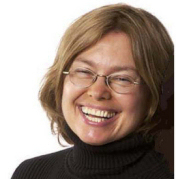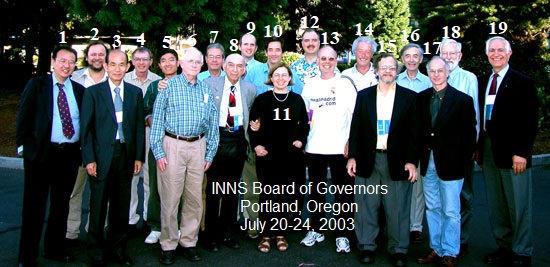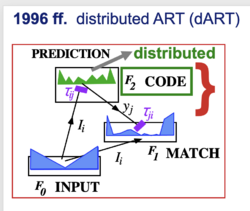Biography:Gail Carpenter
This article or section contains close paraphrasing of a non-free copyrighted source, http://techlab.bu.edu/members/gail/ (Duplication Detector report). (February 2022) (Learn how and when to remove this template message) |
Professor Gail Alexandra Carpenter | |
|---|---|
 Gail Alexandra Carpenter 2005 picture | |
| Born | 1948 (Age 73 in 2022) New York City , New York, USA |
| Citizenship | United States |
| Alma mater | University of Wisconsin–Madison University of Colorado-Boulder |
| Known for | Adaptive Resonance Theory (ART), neural network models and applications |
| Spouse(s) | Stephen Grossberg (m. 1979 -) |
| Children | 1 |
| Awards | IEEE Neural Networks Pioneer (2008) |
| Scientific career | |
| Fields | Mathematics, Neuroscience |
| Institutions | Boston University, Northeastern University, MIT |
| Thesis | Traveling wave solutions of nerve impulse equations |
| Academic advisors | Charles C. Conley |
Gail Alexandra Carpenter, Ph.D (born 1948) is a cognitive scientist, neuroscientist and mathematician. She is now a "Professor Emerita of Mathematics and Statistics, Boston University."[1] She had also been a Professor of Cognitive and Neural Systems at Boston University, and the director of the Department of Cognitive and Neural Systems (CNS) Technology Lab at Boston University.[2]
Early life
Gail Carpenter is the only daughter of Chadwick Hunter "Chad" Carpenter (1920-1996) and Ruth M. (née Stevenson) Carpenter (1920-2010). She has four brothers.[3][4]
Carpenter attended the International School of Geneva (1961-1966) then went to the University of Colorado in Boulder earning a B.A. in 1970 (summa cum laude, mathematics). She then earned a Ph.D. in mathematics at the University of Wisconsin–Madison. Carpenter then taught at MIT and Northeastern University before moving to Boston University.[5]
Carpenter married Stephen Grossberg on June 16, 1979, in Boston University Castle in Boston, Massachusetts .[6]
Adaptive resonance theory
Carpenter's "neural modeling" efforts were clearly seen in her 1974 mathematics PhD thesis on Traveling wave solutions of nerve impulse equations at the University of Wisconsin Department of Mathematics while working with Charles C. Conley. Later she re-defined and expanded her theories in various papers during the mid to late 1970s. She defined the "generalized Hodgkin-Huxley models, used dynamical systems techniques to analyze their solutions, and characterized the qualitative properties of the burst suppression patterns that a typical neuron may propagate: while investigating normal and abnormal signal patterns in nerve cells.[5]
Adaptive resonance theory (ART) is a theory developed by Stephen Grossberg and Gail Carpenter on aspects of how the brain processes information. It describes a number of neural network models which use supervised and unsupervised learning methods, and address problems such as pattern recognition and prediction.[8]
The primary intuition behind the ART model is that object identification and recognition generally occur as a result of the interaction of 'top-down' observer expectations with 'bottom-up' sensory information. The model postulates that 'top-down' expectations take the form of a memory template or prototype that is then compared with the actual features of an object as detected by the senses. This comparison gives rise to a measure of category belongingness. As long as this difference between sensation and expectation does not exceed a set threshold called the 'vigilance parameter', the sensed object will be considered a member of the expected class. The system thus offers a solution to the 'plasticity/stability' problem, i.e. the problem of acquiring new knowledge without disrupting existing knowledge that is also called incremental learning.[8]
Academic acknowledgements
This biographical section is written like a résumé. (February 2022) |
Per Boston University, where Carpenter is a "Professor Emerita of Mathematics and Statistics," she is acknowledged has having been the very first woman to receive the Institute of Electrical and Electronics Engineers (IEEE) Neural Networks Pioneer Award in 2008. She was also elected to successive three-year terms on the Board of Governors of the International Neural Network Society (INNS)[9]) since its founding in 1987, and received the INNS Gabor Award in 1999. She has also served as an elected member of the Council of the American Mathematical Society, and is a charter member of the Association for Women in Mathematics.[10]
Her memberships include[10]
American Mathematical Society (AMS)
Association for Women in Mathematics (AWM)
Institute of Electrical and Electronics Engineers (IEEE)
IEEE Computational Intelligence Society
International Neural Network Society (INNS)
Additional awards and honors include
Institute of Electrical and Electronics Engineers[10]
IEEE Fellow Award (2013)

IEEE Senior Membership Award (2011)
IEEE Neural Networks Pioneer Award (2008)
International Neural Network Society[10]
INNS Fellow Award (2011)
College of Fellows (2011 – )
Governing Board (1987–2010)
Secretary & Executive Committee (1994–2000)
Vice President (1988 1989)
American Mathematical Society[10]
AMS Council – Member at Large (1996–1999)
Committee on the Profession (1996–1999)
Liaison Committee with AAAS (2004–2006)
Editorial Boards[10]
Brain Research
IEEE Transactions on Neural Networks
Neural Networks
Biologically Inspired Cognitive Architectures
Selected published articles
- Carpenter, G. A. (2019). Looking to the future: Learning from experience, averting catastrophe. Neural Networks.
- Carpenter, G. A., & Grossberg, S. (1987). A massively parallel architecture for a self-organizing neural pattern recognition machine. Computer Vision, Graphics and Image Processing, 37(1), 54–115. https://doi.org/10.1016/S0734-189X(87)80014-2
- Carpenter, G. A., Grossberg, S., Markuzon, N., Reynolds, J. H., & Rosen, D. B. (1992). Fuzzy ARTMAP: A Neural Network Architecture for Incremental Supervised Learning of Analog Multidimensional Maps. IEEE Transactions on Neural Networks, 3(5), 698–713. https://doi.org/10.1109/72.159059
- Carpenter, G. A., Grossberg, S., & Reynolds, J. H. (1991). ARTMAP: Supervised real-time learning and classification of nonstationary data by a self-organizing neural network. Neural Networks, 4(5), 565–588. https://doi.org/10.1016/0893-6080(91)90012-T
- Carpenter, G. A., Grossberg, S., & Rosen, D. B. (1991). Fuzzy ART: Fast stable learning and categorization of analog patterns by an adaptive resonance system. Neural Networks, 4(6), 759–771. https://doi.org/10.1016/0893-6080(91)90056-B
References
- ↑ Google Scholar
- ↑ https://mailman.srv.cs.cmu.edu/pipermail/connectionists/1989-December/012034.html |Wang Institute Conference| 1990 bio|
GAIL CARPENTER is Professor of Mathematics and CNS; Co-Director of the
CNS Graduate Program; 1989 Vice President of the International Neural Network
Society (INNS); Organization Chairman of the 1988 INNS annual meeting; Session Chairman at the 1989 and 1990 IEEE/INNS International Joint Conference on Neural Networks (IJCNN); one of four technical consultants to the national DARPA Neural Network Study; editor of the journals "Neural Networks", "Neural Computation", and "Neural Network Review"; and a member of the scientific advisory board of HNC. A leading neural architect, Carpenter is especially well-known for her seminal work on developing the adaptive resonance theory architectures (ART 1, ART 2, ART 3) for adaptive pattern recognition. - ↑ https://www.ancestry.com/discoveryui-content/view/653020371:61843 | Obituary for Ruth S. Carpenter| Accessed 18 January 2022| See also: April 29, 1947 Marriage at: https://www.ancestry.com/discoveryui-content/view/2268275:61406 [user-generated source]
- ↑ https://www.ancestry.com/discoveryui-content/view/613063443:61843%7C Ancestry.com result for Chadwick Hunter Carpenter obit| Accessed 18 January 2022
- ↑ 5.0 5.1 https://techlab.bu.edu/members/gail/%7C CNS Technology Website| Accessed 18 January 2022
- ↑ Newspapers.com| The Jackson Hole Guide; Publication Date: 21/ Jun/ 1979; Publication Place: Jackson, Wyoming, USA; URL: https://www.newspapers.com/image/317801978/?article=793bcdc8-8859-426f-a1ad-06890f4299c4&focus=0.036960505,0.094845355,0.2794417,0.50327265&xid=3398
- ↑ Archival journal article describing the Distributed ART (dART) model is: Carpenter, G.A. (1997). Distributed learning, recognition, and prediction by ART and ARTMAP neural networks. Neural Networks, 10(8), 1473-1494.See Figure 1b.
- ↑ 8.0 8.1 Carpenter, G.A., Grossberg, S., & Reynolds, J.H. (1991), ARTMAP: Supervised real-time learning and classification of nonstationary data by a self-organizing neural network , Neural Networks, 4, 565-588
- ↑ https://www.inns.org/%7C International Neural Network Society (INNS)| Accessed 18 January 2022
- ↑ 10.0 10.1 10.2 10.3 10.4 10.5 "Gail Carpenter | PR Social". https://www.bu.edu/prsocial/profile/gail-carpenter/.
Other sources
Carpenter is also cited in the following book: ’’American Men & Women of Science’’ A biographical directory of today's leaders in physical, biological and related sciences. 23rd edition. Eight volumes. Detroit: Thomson Gale, 2006. (AmMWSc 23)
External links
- Gail Carpenter publications indexed by Google Scholar
- The INNS (International Neural Network Society) history project has been documenting the experiences of pioneers of the INNS field: You Tube video interview with Gail Carpenter, Recorded January 14, 2021.
- INNS History Project.
- Boston University Staff web page for Professor Gail Carpenter.


